
Rootjunky APK To Bypass Google FRP Lock For Itel P40+

Rootjunky APK To Bypass Google FRP Lock For Itel P40+
Factory Reset Protection (FRP) is a security feature built into Android devices running Android 5.1 Lollipop and later versions. It prevents someone from using your phone after a factory data reset without Google account login credentials. The FRP makes it much less attractive for thieves to steal Android phones, knowing they will need help to access them.
FRP automatically activates when you add a Google account to your Android phone. It links the Itel P40+ device to your account, making it the “trusted owner.” Once activated, FRP becomes embedded in the phone’s system.
While Google FRP is a valuable security feature, it’s vital to acknowledge that there are legitimate situations where bypassing it might be necessary. These instances include forgotten Google account credentials, buying a second-hand device, and device issues. In these cases, tools like RootJunky can help you bypass FRP Lock. We’ll explore how to use RootJunky APK later, but first, let’s define what it is and its role in FRP bypass.

The RootJunky APK is a free Android application also called RootJunky SDL or RootJunky FRP Bypass tool. This app’s primary function is to bypass the Google Account FRP lock on Samsung devices. Rootjunky uses the weaknesses in Android’s setup process to create a new user account or switch existing ones, letting you bypass the FRP and regain control of your phone.
You can complete this process using the app by connecting your phone to a computer through an OTG cable. RootJunky can be helpfu l if you’ve forgotten your Google account password or bought a second-hand phone locked to someone else’s account. However, only use it if you have legitimate reasons to bypass FRP lock, like accessing your device after forgetting your Google account details.

Downloading the RootJunky FRP bypass tool from unofficial sources can introduce malware risks, so stick to trusted sources like the official website. Additionally, when exploring RootJunky, it is vital to keep the following in mind:
- Not all Android devices are susceptible to the methods used by RootJunky. It is necessary to check compatibility with your specific device model and Android version.
- Using FRP bypass tools like RootJunkycan potentially compromise the security of your device. Be cautious and proceed if you fully understand the risks involved.
- Bypassing FRP may involve data loss.
- Download RootJunky FRP bypass APK from a reliable source to minimize the risk of malware or viruses. You can check the APK file from official websites or trusted forums.
- Google constantly updates its security measures, so these tools may not always work effectively.
Part 2: How To Use RootJunky To Bypass Google FRP?
Here are the general steps to use the FRP Bypass APK RootJunky app to bypass Google FRP lock. But remember that specific steps may vary depending on your device and Android version:
- Step 1: On your computer, download the Rootjunky RealTerm program from the official Rootjunky website.

- Step 2: On your phone, download the Rootjunky APK (com.rootjunky.frpbypass-1.0.apk) file from the official website or other reputable sites.

- Step 3: Go to Settings > Security and tap Install unknown apps. Then, enable unknown sources to allow installation of apps from outside the Play Store. Connect your device to a Wi-Fi network.

- Step 4: On your Android phone, open a file explorer app and install the downloaded RootJunky APK file.
- Step 5: Connect your smartphone to your computer using a USB cable.
- Step 6: Launch the Rootjunky RealTerm program on your computer. Under the Display tab, check the Half Duplex option.
- Step 7: On your computer, go to Device Manager > Modems. Locate your device’s port name (e.g., COM3).
- Step 8: On the RealTerm program, enter the correct port number under the Ports tab, then click Change.

Step 9: Click Send to establish a connection. Enter the two commands:
at + creg? \ r \ n
atd1234; \ r \ n
Step 10: Once connected, the Rootjunky APK on your phone will provide on-screen instructions to bypass FRP.
Step 11: If prompted, perform a factory data reset of your device.
While RootJunky offers a free method for FRP bypass, it can be incompatible with your device’s brand, requiring technical knowledge, tedious, and potentially risky. If you are looking for a simpler, safer, and more user-friendly solution, Wondershare Dr.Fone might be a better fit for you. If you want to learn how to use this tool to bypass FRP lock with minimal technical expertise, then keep reading.
Part 3: Easier Tool Than RootJunky APK To Bypass Google FRP
Google FRP adds an extra layer of security after a device reset. However, regaining access to the smartphone can be challenging if you forget your Google account details, forget your lock screen, or just buy a used device. While methods like the FRP RootJunky app exist, using it can be complex or risky.
Consider exploring third-party options like Dr.Fone for a potentially easier and safer FRP bypass solution. Dr.Fone Screen Unlock tool helps remove the Android FRP lock without requiring a PIN or Google Account.
Why Use Dr.Fone - Screen Unlock?
Here are some of the key features of Dr.Fone - Screen Unlock:
- **User-friendly:**Fone boasts an intuitive interface, eliminating the need for technical expertise. Even beginners can navigate the process with ease.
- **Widespread Brand Compatibility:**Fone supports mainstream brands, such as Samsung, Xiaomi, Oppo, Redmi, Realme, and Vivo, catering to a broader user base.
- **Fast and Efficient:**Regain access to your device in minutes without wasting time on tedious procedures.
Step-by-step Guide to Removing FRP Lock With Dr.Fone - Screen Unlock
Ready to leave the hassle of using RootJunky and easily bypass the FRP lock? Download and install Dr.Fone on your computer, then follow these steps to learn how to bypass Google FRP on your device:
- Step 1: Launch Dr.Fone on your computer and connect it to your Android device. Choose Screen Unlock from the Toolbox in the main interface.

- Step 2: Choose Android as your device type. This will take you to the next screen, where you can select Remove Google FRP Lock to proceed.

- Step 3: Select your device’s brand from the list and click Start to continue.
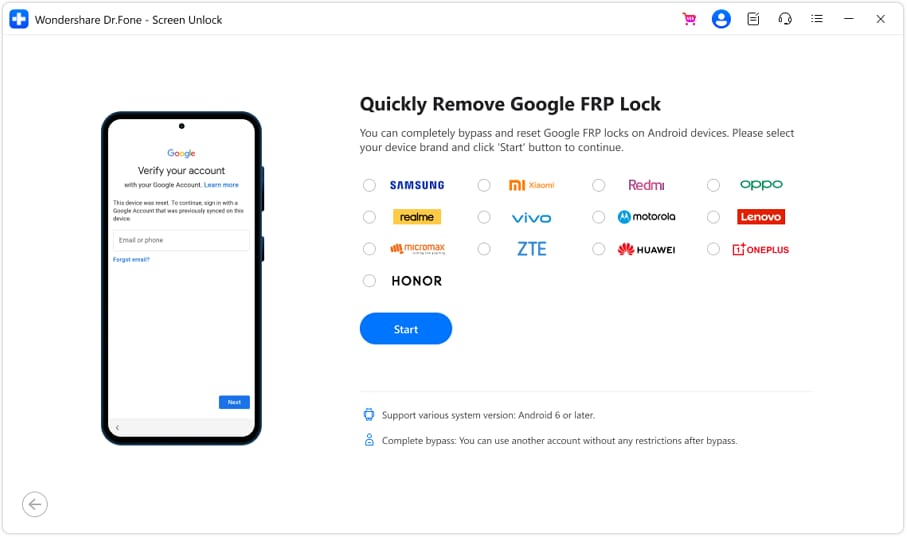
Note:
The next steps may vary depending on the brand you selected.
- Step 4: Select the OS version of your device and click Start to continue.
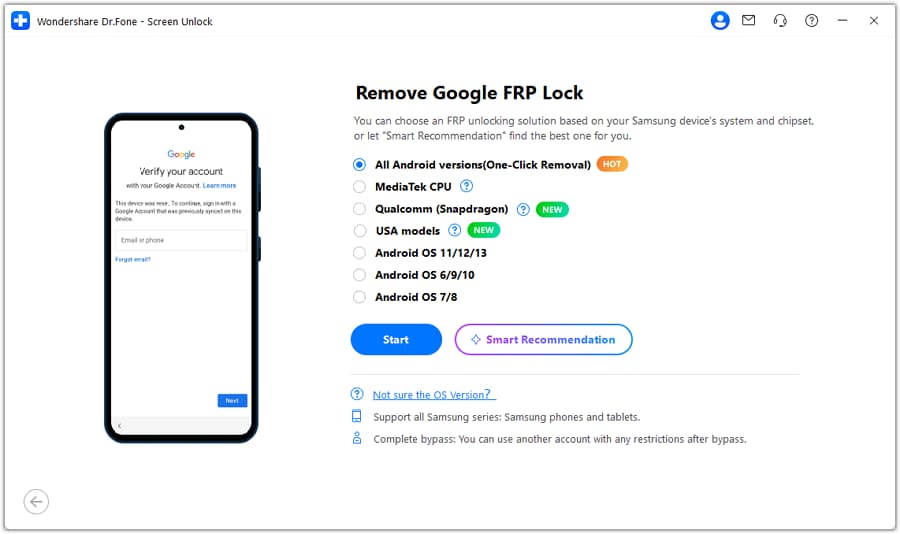
- Step 5: Access the secret menu on your phone using the on-screen instructions, then click Next to proceed to the next step.
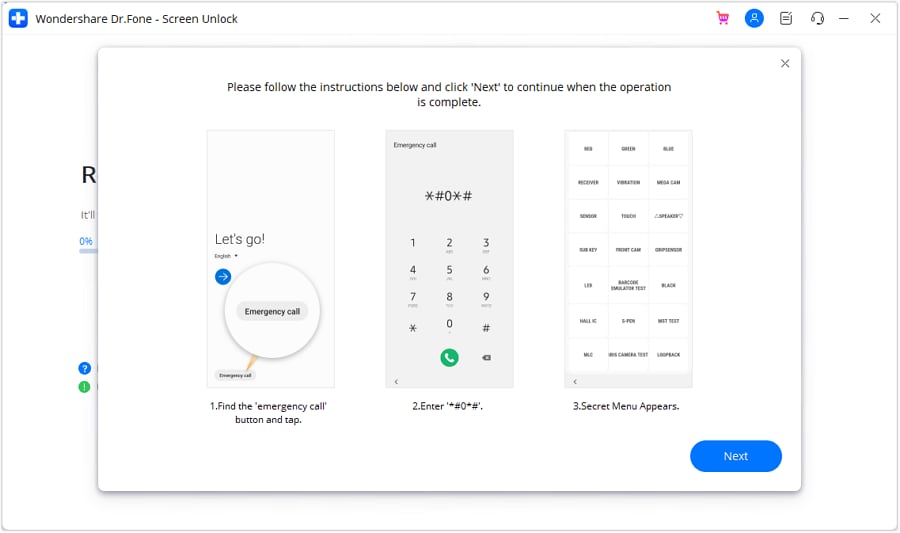
- Step 6: When your Samsung prompts you to activate USB debugging, tap Allow. Then, on your computer screen, click Authorized to confirm.

- Step 7: You will see the FRP lock being bypassed on your Android device on the next screen.
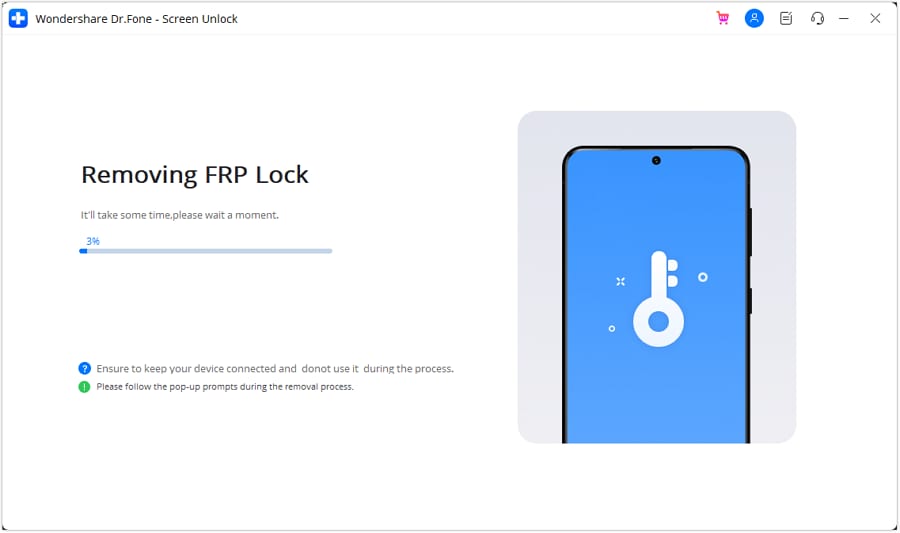
- Step 8: Click Done if the FRP lock removal was successful, otherwise, click Try Again to repeat the process.
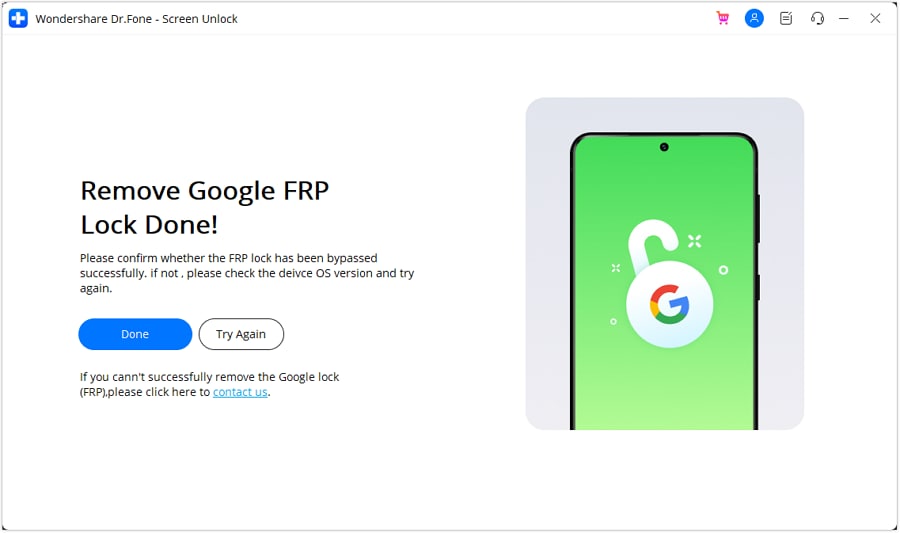
That’s it! With Dr.Fone Screen Unlock, you can easily bypass Google FRP and regain access to your Android device, leaving the complexities of RootJunky behind.
Tips: Are you searching for a powerful FRP bypass tool? No worries as Dr.Fone is here to help you. Download it and start a seamless unlock experience!
Conclusion
Both RootJunky and Dr.Fone offer options for you to regain control of phones with Google FRP lock. FRP Bypass RootJunky tool excels with its free-to-use approach, perfect for tech-savvy users comfortable with APK installations. While requiring a paid subscription, Dr. Fone provides pre-rooted firmware installations and broader device compatibility, which is ideal for those seeking a more streamlined but supported experience.
The best choice boils down to your personal needs and budget. Remember, FRP bypass should only be utilized by rightful owners facing genuine lockouts. When used responsibly, these tools can help you access your phone after a factory reset even without your Google account credentials. Choose the tool that best fits your needs and proceed with caution. Use these tools responsibly and regain access to your device the right way.
7 Ways to Unlock a Locked Itel P40+ Phone
“How to get into a locked phone? I have been locked out of my Android device and lost my passcode!”
If you are also facing the same issue, then you have come to the right place. There are plenty of ways to learn how to get into a locked Android phone when it comes to Android devices. From using a third-party tool to Google’s native solution – the sky is the limit. This post will make you familiar with different ways to unlock a device without knowing its passcode. Read on and learn how to get into a locked Android device.

Part 1: How to get into a locked phone with Dr.Fone?
Dr.Fone - Screen Unlock (Android) provides a hassle-free solution to unlock an Android device in minutes. It can remove a device’s PIN, password, pattern, and even fingerprint security without causing any harm to it. Therefore, you would be able to unlock your device without losing your data while using some Samsung or LG Android phones. If you want to break the locked screen with Dr.Fone from other brand phones, including iPhone, Huawei, and Oneplus, it will wipe out your phone’s data after unlocking successfully.

Dr.Fone - Screen Unlock (Android)
Get into Locked Phones within Minutes
- 5 screen lock types are available: pattern, PIN, password, fingerprints & Face ID.
- Easily remove the lock screen; No need to root your device.
- Everybody can handle it without any technical background.
- Provide specific removal solutions to promise good success rate.
4,008,669 people have downloaded it
To learn how to get into a locked phone using Dr.Fone, follow these steps:
- Step 1. Go to the official website of Dr.Fone - Screen Unlock (Android) and download the tool on your computer. After installing it, launch the interface and click on the option of “Screen Unlock” from the home screen.

- Step 2. Connect your Android device to the computer. Click “Android” > “Unlock Android Screen” and select the Itel P40+ device brand on the list. If your device is listed in the supported list , you can unlock locked phone without data loss.

- Step 3. Now, you need to put your Android device in Download mode. To do this, you need to turn your device off by pressing the Power button. Afterward, press the Home, Power, and Volume Down buttons together. After a while, let go of these buttons and press the Volume Up button to enter the Download Mode.
- Step 4. As soon as your device is not in the Download Mode, Dr.Fone will automatically start downloading its respective recovery packages.
- Step 5. Sit back and wait as the application downloads the package and performs the required steps to unlock your device. In the end, it will notify you by displaying the following message.

That’s it! By following these steps, you would be able to learn how to get into a locked Android phone without losing any data.
Tips: Cannot find your device model in the supported list or your phone is not Samsung? Worry not, as Wondershare Dr.Fone can also help you to unlock other device models (inlcluding Huawei, LG, Xiaomi, etc) in a matter of seconds. Just install this tool on your computer and connect your phone to start the unlock process!
Part 2: How to get into a locked phone with Android Device Manager?
Google’s Android Device Manager (also known as Find My Device) can be used to locate a lost phone, erase it remotely, ring it, and change its lock. You can access it from any other device and use its features remotely.
- Step 1. Firstly, go to the Android Device Manager’s website right here . Log in with the Google account that is already linked to your Android device.
- Step 2. Once the interface is loaded, you can select your phone. It will locate the Itel P40+ device automatically and provide various options.

- Step 3. Choose the “Lock” option to proceed.
- Step 4. This will display a new prompt. From here, you can get the new password for your device and confirm it.

- Step 5. Additionally, if your device is lost, you can display an optional message and contact number on the lock screen. Click on the “Lock” button to save changes and exit the screen.
Part 3: How to get into a locked phone with Samsung Find My Mobile?
If you are using a Samsung device, you can also use its Find My Mobile service to unlock your device remotely. It is an excellent tool that can be accessed remotely and perform a wide range of operations that can be performed on the Itel P40+ device. Follow these easy instructions to learn how to get into a locked Android Samsung device.
- Step 1. Open Samsung’s Find My Mobile website right here on any device of your choice.
- Step 2. Login using the credentials of the Samsung account linked to your existing device that is needed to be unlocked.
- Step 3. On its dashboard, you can access various features associated with your device. If you have multiple devices linked to your account, you can select it from the top-left panel.

- Step 4. From the provided options on the left panel, click on the “Unlock My Screen” option.
- Step 5. Click on the “Unlock” button again to move past the lock screen of your device.

- Step 6. After waiting for a while, you will get the following prompt. From here, you can set up a new lock for your mobile or can click on the “Lock My Screen” option to do the same.
Part 4: How to get into a locked phone using the ‘Forgot Pattern’ feature?
If your device is based on Android 4.4 and earlier versions, you may also use its native “Forgot Pattern” feature to unlock it. Though, you should have access to the Google account credentials linked to the Itel P40+ device beforehand. To learn how to get into a locked phone with this technique, follow these steps:
- Step 1. To get the Forgot Pattern option, enter the wrong PIN/pattern on your device.
- Step 2. This will display the “Forgot Pattern” button on the bottom of the screen. Just tap on it to continue.

- Step 3. On the next screen, you can unlock your device by providing the backup PIN of your device or sign in using the Google credentials of the account linked to the Itel P40+ device.

- Step 4. After bypassing this feature, you can unlock your device and set up a new PIN or pattern.
Parental Control Software
## Part 5: How to get into a locked phone by factory reset?If nothing else seems to work, then you can also choose to factory reset your device. Even though this will unlock your device, it would also erase its content and saved settings. To know how to get into a locked Android phone, follow these steps:
- Step 1. Turn off your device by pressing the Power button.
- Step 2. Now, you need to put your device into recovery mode. This can be done by applying the correct key combinations, which can differ from one device to another. Some common combinations are: Volume Up + Home + Power, Home + Power, Volume Up + Power + Volume Down, and Volume Down + Power button.
- Step 3. Once your phone has entered the recovery mode; you can navigate with the Volume up and down button and use the Power button to make a selection.

- Step 4. Select the option of “wipe data/factory reset.
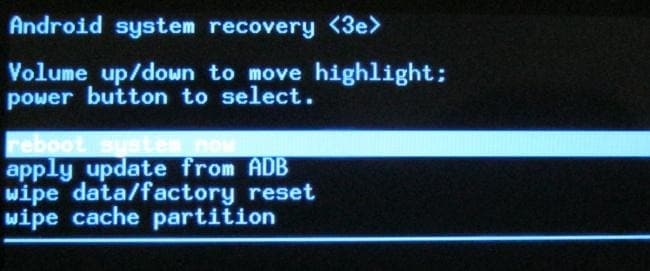
- Step 5. This will display the following prompt. Confirm your choice by selecting the “Yes” option.

- Step 6. Wait for a while as your phone will be restarted with factory settings.
Part 6: How to get into a locked phone in Safe Mode?
If you are using a third-party application to lock your device, you can easily disable it by restarting your phone in safe mode. In this way, you can get rid of the respective app without causing any damage to the Itel P40+ device. You can learn how to get into a locked Android phone by following these steps:
- Step 1. Long-press the Power button to activate the Power option on the screen.
- Step 2. If you don’t get the option to restart the phone in Safe Mode, then long tap the “Power off” option.
- Step 3. It will provide the following prompt regarding Safe Mode. Just tap on the “Ok” button to confirm your choice.

Part 7: How to get into a locked phone using Custom Recovery?
Since custom recovery provides a third-party recovery environment, it can learn how to get into a locked Android device. Additionally, you need to flash it via an SD card since you won’t access the phone storage on a locked device.
- Step 1. To start with, you need to download the password/pattern disable file from right here and copy it onto your SD card.
- Step 2. Mount the SD card on your device and restart it in recovery mode by providing the correct key combinations.
- Step 3. From the provided options, choose to install zip from the SD card.
- Step 4. Confirm your selection and let your phone be restarted with no lock screen.

Bonus Tip: General tips for unlocking phone successfully
By following these tips, you can increase the chances of successfully unlocking your phone while safeguarding your data and security.
- Data Backup: Regularly back up your data that ensures you have a recent backup of all your important data, such as contacts, photos, videos, and documents. This will prevent data loss in case the unlocking process results in a factory reset.
- Reputable Methods: Use reputable and official unlocking methods whenever possible, such as Dr.Fone - Screen Unlock.
Conclusion
By following these simple steps, you would learn how to get into a locked phone. If you are looking for a trouble-free way to unlock an Android device, then give Dr.Fone - Screen Unlock a try. It is a highly reliable solution to learn how to get into a locked Android phone and unlock your device in minutes with no complications.
Pattern Locks Are Unsafe: Secure Your Itel P40+ Phone Now with These Tips
Pattern locks have been available for about as long as people can remember, and they have been hugely popular with people thanks to how easy it is to simply swipe your screen and unlock your smartphone, as against, say, keying in the 4-digit PIN/ 6-digit PIN. However, pattern locks are easy to crack, and today, we bring you all you want to know about pattern locks and how to create a hard pattern lock. Further to this, we also tell you how to move beyond pattern locks and what to do in case you forgot the hard pattern lock you just set and are unable to unlock your smartphone.

Part 1: What You Need to Know About Pattern Locks
Pattern lock is an Android-only feature that makes it easy for users to have a modicum of security on their smartphones. Most users do not prefer using and remembering a PIN to unlock the smartphone. Creating a pattern makes it easier, somehow.
There is a 9-point grid on which you swipe your finger from point to point, in any direction, and when you take your finger off, that pattern you swiped becomes the key to unlock your smartphone.
Pattern locks were exceedingly common only a few years ago, and they are not recommended for use any longer due to concerns (mentioned later in the article).
1.1: Popularity and Usage
Old habits die hard, or so they say, right? That’s because it is true. We are creatures of habit, and pattern locks have been around for a long, long time. We are accustomed to pattern locks. So, even with even easier technologies such as fingerprint recognition and face recognition, we tend to gravitate towards the familiar old pattern lock.
The only thing is, there is a reason why pattern locks are no longer the preferred option to use for unlocking your smartphones. As it happens, that reason is security, and it can be very easy for humans to take a swipe (pardon the pun) at your pattern lock. And guess what? The research conducted suggests that they would get it right with an unsettling accuracy.
1.2: Advantages and Drawbacks
With on-the-go lifestyles, our smartphones have become indispensable and contain some of the most sensitive aspects of our lives – IDs, credit and debit cards in digital wallets, photo and video memories, business documents – you name it, the smartphones have it, on the go. This has opened our lives up to the public at large, and if someone steals our smartphone or, best case, finds it, the only barrier preventing them from being privy to all that wealth of our sensitive information is that screen lock – the pattern lock that we set on our smartphones. That’s it – the single pattern lock stands between malicious actors and our data. You might be beginning to realize just how crazy this is.
Advantages of Pattern Locks
There are two advantages to using pattern locks. One, they are better than nothing. Two, they are easy to use. And that’s about it. There is no third advantage to pattern locks. We might think we set a hard pattern lock that nobody could guess, but, as research proves, we might be thinking too low of human prowess.
Disadvantages of Pattern Locks
Security, or rather, the lack of it, is the lone disadvantage of using a pattern lock. What good is a pattern lock that can be easily deciphered? Sure, they are easy to use, and they are better than not having anything, but would you really want to protect your life’s data with something that could be, as researchers found out, breached in under 5 attempts? We don’t think you do!
The research found that 64% of test subjects who were shown videos of people unlocking their phones could correctly guess a 6-point pattern lock, that too after viewing the video only once! That number shot up to 80% if they were allowed to see the video again. That is simply astounding and a nightmare for security. When it comes to PINs, only 11% could guess a 6-digit PIN after viewing the unlocking video once, and that number shot up to 27% when they could see the video two times.
Part 2: How To Create a Hard Pattern Lock (Including Remembering Complex Patterns)
Now, if you must continue using a pattern lock, let’s help you know how to create a hard pattern lock that would not be as easy to decipher as easy pattern locks. For that, you should know how people use pattern locks, the kind of pattern locks they create, and the ones that are the most commonly used pattern locks. That way, you can avoid those fallacies and create a hard pattern lock for your smartphone.
2.1: The Pattern Locks People Use Most Commonly

Marte Loge, an M.Sc. Computer Science student, gave a presentation on pattern locks at DEFCON 23 and made a bold claim. She said, “Tell me who you are, and I will tell you your lock pattern.”
She presented the following statistics to support her claim:
- - In her research, she found that 77% of people started with one of the 4 corners when creating a pattern lock.
- - 44% of people started with the top-left dot and 15% with the top-right, while the bottom-left was preferred by 14% of her test subjects.
- - People set 5-point pattern locks on average, and most users were content with a 4-point pattern.
These are some of the most common pattern locks people create:
- - patterns in the shapes of alphabets,
- - patterns in the shapes of numerals,
- - patterns in any other simple shape, such as square, triangle, star, etc.
To understand how this is a security nightmare, the possible combinations for a 4-point pattern are a measly 1624, whereas by adding just 1 more point to the pattern and creating a 5-point pattern, the number of possible combinations becomes 7152, an increase of 5528 combinations. In stark contrast, creating a 9-point pattern would give you over 140,000 possible combinations!
2.2: How to Create a Hard Pattern Lock
Knowing what most people do when creating a pattern lock, it becomes easy to avoid those mistakes and instead create a hard pattern lock for oneself.
- - Do not start creating a pattern lock from any of the 4 corners of the grid.
- - Never use your first initial as your pattern lock.
- - Never use the shape of a numeral as your pattern lock.
- - Use all 9 points on the grid to create your pattern lock, and contrary to popular belief, you can go over the connecting lines several times, creating a hard pattern lock that would not be as easy for people to decipher!
Part 3: Going Beyond Pattern Locks
You might think that now that you have set a hard pattern lock, you are good to go. Hardly. Technology has evolved, so have methods to break into your device.
Step 1: Set a 6-digit PIN
The minimum you should do today is set a 6-digit PIN to unlock your phone. Consider this a necessary investment into the safety of your data residing on your smartphone.
Step 2: Use Fingerprint Recognition (or Face Recognition on Apple Devices)
All modern smartphones released over the last decade have come with fingerprint recognition. Using fingerprint recognition requires you to set a 6-digit PIN and then set a fingerprint to unlock your device. You can set additional fingerprints, too.
This way, your device is the most secure it can be today. In case your fingerprint is not recognized for any reason, the phone falls back on the 6-digit PIN that you can enter and unlock your phone.
While face recognition is available on both Android and Apple devices, it is truly secure only on Apple devices. This is why Apple iPhones released after the iPhone X in 2017 have come only with Face ID. They fall back on a minimum 6-digit PIN (called Passcode in Apple world) to unlock in case the face does not get recognized in the first attempt.
Part 4: How To Unlock Phone If Hard Pattern Lock Forgotten
Just in case you set a hard pattern lock and promptly forgot that abstruse pattern you just set, we have a tool for you to quickly unlock your phone in case of a forgotten hard pattern lock: Wondershare Dr.Fone - Screen Unlock.

Dr.Fone - Screen Unlock (Android)
Remove the Hard Pattern Lock on Your Itel P40+ If You Forgot!
- Remove all Android screen locks (PIN/pattern/fingerprints/face ID) in minutes.
- Bypass the FRP lock of Samsung without a PIN or Google account.
- Everyone can handle the lock screen without any tech knowledge.
- Provide specific removal solutions to promise good success rate.
4,008,671 people have downloaded it
Download the latest version of Dr.Fone from the Wondershare website and launch the app.

Step 1: Click Android under Toolbox > Screen Unlock.

Step 2: Click Unlock Android Screen.

Step 3: Select your device manufacturer.

Step 4: Prepare your device to unlock the screen.

When the greyed Next button becomes available, click it and wait for your device to be unlocked.

All data on the Itel P40+ device is wiped under this method. Select Samsung phones may be unlocked without data loss. Check this list for devices that may be unlocked without data loss.
Closing Words
Whether it is an easy pattern lock or a hard pattern lock, the fact is that pattern locks are antiquated and a security nightmare. A minimum 6-digit PIN must be used, and using fingerprint recognition is the preferred way to go for Android devices. Using fingerprint recognition will require that users create a 6-digit PIN. On Apple devices launched after 2017, there is Face ID, Apple’s marketing term for face recognition. If you did indeed still set a hard pattern lock, only to promptly forget it, use Wondershare Dr.Fone – Screen Unlock (Android) to seamlessly unlock your phone right now.
- Title: Rootjunky APK To Bypass Google FRP Lock For Itel P40+
- Author: Marry
- Created at : 2024-07-18 16:16:47
- Updated at : 2024-07-19 16:16:47
- Link: https://unlock-android.techidaily.com/rootjunky-apk-to-bypass-google-frp-lock-for-itel-p40plus-by-drfone-android/
- License: This work is licensed under CC BY-NC-SA 4.0.




